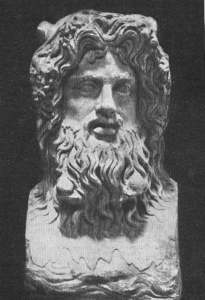This large altar in white Carrara marble was discovered in 1965 in the waters of the quay of Ripa Puteolana. It was topped by sacred Betyls and characterized by a large inscription dedicated to the god Dushara, and it constitutes – along with slabs and other two smaller altars (the latter was included in the collection of the Museum of Naples already in the XVIII century) – a proof of the presence of a place of worship built by Nabatean Arabs, today submerged.
Originating from present-day Syria, the Nabataeans had a trading post in the port of Puteoli, like other communities of foreigners from Egypt, Tyre, Baetica. Each community imported also the respective national cult.

Colossal head of the god Dushara from Puteoli, now in the Vatican Museums (Lacerenza 1991, p. 137)
The marble basis of the artefact presents little traces of a biological attack from endolithic sponges that resulted in branched tunnels of different diameters, especially in the first millimetres of the stone’s thickness, and sometimes visible even on the surface.
The travertine Betyls show an evident degradation of the stone due to various biological agents. The tunnels that still host the shells of bivalve boring molluscs belonging to the species Lithophaga lithophaga L. (so-called date mussel) are particularly evident.
The parts in which the outer layer of stone is still preserved show circular millimetric holes (pitting), which can be attributed to the growth of endolithic sponges.
In the parts where the outer layer has been lost, many deep sub-spherical chambers that hosted the body of the sponge are clearly visible. The observations under an electron microscope, carried out on tiny fragments, allowed for identifying the sponge responsible for the degradation: the pits with a smooth surface (traces) and tilostile spicules (pin-shaped skeleton elements) allow for attributing the attack to the species of Cliona Celata Grant.

Amalfitano, P., Camodeca, G. and Medri, M., 1990. I Campi Flegrei : un itinerario archeologico. Venezia: Marsilio.
Camodeca, G. (1994) ‘Puteoli porto annonario e il commercio del grano in età imperiale’, in Le Ravitaillement en blé de Rome et des centres urbains des débuts de la République jusqu’au Haut-Empire. Actes du colloque international de Naples, 14-16 Février 1991, pp. 103–128.
Davidde B., Ricci S., Poggi D., Bartolini M., 2010. Marine bioerosion of stone artefacts preserved in the Museo Archeologico dei Campi Flegrei in the Castle of Baia (Naples), Archaeologia Maritima Mediterranea; 7: 75-115.
Lacerenza, G., 1991. Il dio Dusares a Puteoli. Puteoli, XII-XIII, 1991, pp. 119-149.
Ricci S., Sacco Perasso C., Antonelli, F., Davidde Petriaggi B., 2015. Marine Bivalves colonizing roman artefacts recovered in the Gulf of Pozzuoli and in the Blue Grotto in Capri (Naples, Italy): boring and nestling species. International Biodeterioration & Biodegradation (98) 89 – 100.
Ricci, S., Pietrini, A. M., Bartolini, M., Sacco Perasso, C., 2013. Role of the microboring marine organisms in the deterioration of archaeological submerged lapideous artifacts (Baia, Naples, Italy). International Biodeterioration & Biodegradation 82 (2013) 199-206.
Ricci S., Davidde B., Bartolini M., Priori G. F., 2009. Bioerosion of lapideous objects found in the underwater archaeological site of Baia (Naples). Archaeologia Maritima Mediterranea, 6: 167-188.



